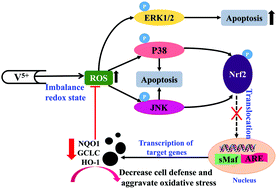当前位置:
X-MOL 学术
›
Metallomics
›
论文详情
Our official English website, www.x-mol.net, welcomes your
feedback! (Note: you will need to create a separate account there.)
Vanadate oxidative and apoptotic effects are mediated by the MAPK-Nrf2 pathway in layer oviduct magnum epithelial cells
Metallomics ( IF 2.9 ) Pub Date : 2017-09-18 00:00:00 , DOI: 10.1039/c7mt00191f Jianping Wang 1, 2, 3, 4, 5 , Xuanyang Huang 1, 2, 3, 4, 5 , Keying Zhang 1, 2, 3, 4, 5 , Xiangbing Mao 1, 2, 3, 4, 5 , Xuemei Ding 1, 2, 3, 4, 5 , Qiufeng Zeng 1, 2, 3, 4, 5 , Shiping Bai 1, 2, 3, 4, 5 , Yue Xuan 1, 2, 3, 4, 5 , Huanwei Peng 1, 2, 3, 4, 5
Metallomics ( IF 2.9 ) Pub Date : 2017-09-18 00:00:00 , DOI: 10.1039/c7mt00191f Jianping Wang 1, 2, 3, 4, 5 , Xuanyang Huang 1, 2, 3, 4, 5 , Keying Zhang 1, 2, 3, 4, 5 , Xiangbing Mao 1, 2, 3, 4, 5 , Xuemei Ding 1, 2, 3, 4, 5 , Qiufeng Zeng 1, 2, 3, 4, 5 , Shiping Bai 1, 2, 3, 4, 5 , Yue Xuan 1, 2, 3, 4, 5 , Huanwei Peng 1, 2, 3, 4, 5
Affiliation

|
Vanadium is a metal of high physiological, environmental and industrial importance. However, vanadium-induced oxidative stress can reduce the egg quality of poultry, and be potentially harmful to humans, and the underlying mechanism is not clear. In this study, we investigated the underlying relationship between the oxidant-sensitive mitogen-activated protein kinase (MAPK) signaling pathway and vanadium-induced oxidative stress in oviduct magnum epithelial (OME) cells. Cultured OME cells were treated with 100 μmol L−1 vanadium and/or MAPK inhibitors [P38 MAPK inhibitor, SB203580; extracellular regulated protein kinase 1 and 2 (ERK1/2) inhibitor, U0126; c-JUN N-terminal kinases (JNK) inhibitor, SP600125]. Cell viability, apoptosis, and generation of reactive oxygen species (ROS) were assessed using flow cytometry. The expression of oxidative stress-related genes and their proteins was measured by reverse transcription-polymerase chain reaction and western blotting. Vanadium treatment reduced cell viability, whereas pretreated OME cells with SB203580 and U0126 prevented the reducing effect of vanadium on cell viability (P < 0.05). Likewise, MAPK inhibitors effectively suppressed vanadium-induced apoptosis and ROS generation (P < 0.05). In the OME cells treated with vanadium, SB203580 (P < 0.05) and SP600125 (P = 0.08) increased catalase activity by 89.3% and 55.3%; SB203580 and U0126 increased (P < 0.05) glutathione peroxidase activity by 44.9% and 51.1%, respectively. Incubation of OME cells with MAPK inhibitors also prevents malondialdehyde concentration increase and lactic dehydrogenase activity decrease in response to vanadium (P < 0.05). Vanadium downregulated P38, ERK1/2, JNK, Nrf2, sMaf, GCLC, NQO1 and HO-1 mRNA expression (P < 0.05). In contrast, inhibition of JNK with SP600125 upregulated P38, ERK1/2, JNK, Nrf2, GCLC and HO-1 mRNA expression (P < 0.05); inhibition of P38 with SB203580 upregulated JNK, NQO1 and HO-1 mRNA expression (P < 0.05); and inhibition of ERK1/2 with U0126 upregulated ERK1/2, GCLC and HO-1 mRNA expression (P < 0.05). Moreover, phosphorylation of P38, ERK1/2, JNK, and Nrf2 proteins was enhanced by V incubation; however, SP600125 blocked the phosphorylation of these proteins, whereas SB203580 blocked the phosphorylation of P38 and Nrf2. These results indicate that vanadium inducing oxidative stress in OME cells might be, at least, associated with the phosphorylation of the P38MAPK/JNK-Nrf2 pathway, which reduces the expression of phase II detoxifying enzymes.
中文翻译:

钒酸盐的氧化和凋亡作用由层输卵管大细胞上皮细胞中的MAPK-Nrf2途径介导
钒是具有重要的生理,环境和工业重要性的金属。但是,钒诱导的氧化应激会降低家禽的蛋品质,并可能对人体有害,其潜在机理尚不清楚。在这项研究中,我们调查了氧化敏感性丝裂原激活的蛋白激酶(MAPK)信号传导途径与钒诱导的输卵管大上皮(OME)细胞中的氧化应激之间的潜在关系。用100μmolL -1处理培养的OME细胞钒和/或MAPK抑制剂[P38 MAPK抑制剂,SB203580;细胞外调节蛋白激酶1和2(ERK1 / 2)抑制剂,U0126;c-JUN N末端激酶(JNK)抑制剂SP600125]。使用流式细胞仪评估细胞活力,凋亡和活性氧(ROS)的生成。氧化应激相关基因及其蛋白的表达通过逆转录-聚合酶链反应和蛋白质印迹法进行测量。钒处理降低了细胞活力,而用SB203580和U0126预处理的OME细胞阻止了钒对细胞活力的降低作用(P <0.05)。同样,MAPK抑制剂可有效抑制钒诱导的细胞凋亡和ROS的产生(P <0.05)。在用钒处理的OME细胞中,SB203580(P<0.05)和SP600125(P = 0.08)将过氧化氢酶活性分别提高了89.3%和55.3%; SB203580和U0126分别提高(P <0.05)谷胱甘肽过氧化物酶活性44.9%和51.1%。将OME细胞与MAPK抑制剂一起孵育还可以防止丙二醛浓度增加和响应钒的乳酸脱氢酶活性降低(P <0.05)。钒下调P38,ERK1 / 2,JNK,Nrf2,sMaf,GCLC,NQO1和HO-1 mRNA表达(P <0.05)。相反,用SP600125抑制JNK会上调P38,ERK1 / 2,JNK,Nrf2,GCLC和HO-1 mRNA的表达(P <0.05)。SB203580上调JNK,NQO1和HO-1 mRNA表达抑制P38(P<0.05); U0126上调ERK1 / 2,GCLC和HO-1 mRNA的表达来抑制和抑制ERK1 / 2(P <0.05)。此外,通过V孵育可以增强P38,ERK1 / 2,JNK和Nrf2蛋白的磷酸化。但是,SP600125阻止了这些蛋白质的磷酸化,而SB203580阻止了P38和Nrf2的磷酸化。这些结果表明钒诱导OME细胞中的氧化应激至少可能与P38MAPK / JNK-Nrf2途径的磷酸化有关,这会降低II期解毒酶的表达。
更新日期:2017-11-16
中文翻译:

钒酸盐的氧化和凋亡作用由层输卵管大细胞上皮细胞中的MAPK-Nrf2途径介导
钒是具有重要的生理,环境和工业重要性的金属。但是,钒诱导的氧化应激会降低家禽的蛋品质,并可能对人体有害,其潜在机理尚不清楚。在这项研究中,我们调查了氧化敏感性丝裂原激活的蛋白激酶(MAPK)信号传导途径与钒诱导的输卵管大上皮(OME)细胞中的氧化应激之间的潜在关系。用100μmolL -1处理培养的OME细胞钒和/或MAPK抑制剂[P38 MAPK抑制剂,SB203580;细胞外调节蛋白激酶1和2(ERK1 / 2)抑制剂,U0126;c-JUN N末端激酶(JNK)抑制剂SP600125]。使用流式细胞仪评估细胞活力,凋亡和活性氧(ROS)的生成。氧化应激相关基因及其蛋白的表达通过逆转录-聚合酶链反应和蛋白质印迹法进行测量。钒处理降低了细胞活力,而用SB203580和U0126预处理的OME细胞阻止了钒对细胞活力的降低作用(P <0.05)。同样,MAPK抑制剂可有效抑制钒诱导的细胞凋亡和ROS的产生(P <0.05)。在用钒处理的OME细胞中,SB203580(P<0.05)和SP600125(P = 0.08)将过氧化氢酶活性分别提高了89.3%和55.3%; SB203580和U0126分别提高(P <0.05)谷胱甘肽过氧化物酶活性44.9%和51.1%。将OME细胞与MAPK抑制剂一起孵育还可以防止丙二醛浓度增加和响应钒的乳酸脱氢酶活性降低(P <0.05)。钒下调P38,ERK1 / 2,JNK,Nrf2,sMaf,GCLC,NQO1和HO-1 mRNA表达(P <0.05)。相反,用SP600125抑制JNK会上调P38,ERK1 / 2,JNK,Nrf2,GCLC和HO-1 mRNA的表达(P <0.05)。SB203580上调JNK,NQO1和HO-1 mRNA表达抑制P38(P<0.05); U0126上调ERK1 / 2,GCLC和HO-1 mRNA的表达来抑制和抑制ERK1 / 2(P <0.05)。此外,通过V孵育可以增强P38,ERK1 / 2,JNK和Nrf2蛋白的磷酸化。但是,SP600125阻止了这些蛋白质的磷酸化,而SB203580阻止了P38和Nrf2的磷酸化。这些结果表明钒诱导OME细胞中的氧化应激至少可能与P38MAPK / JNK-Nrf2途径的磷酸化有关,这会降低II期解毒酶的表达。











































 京公网安备 11010802027423号
京公网安备 11010802027423号